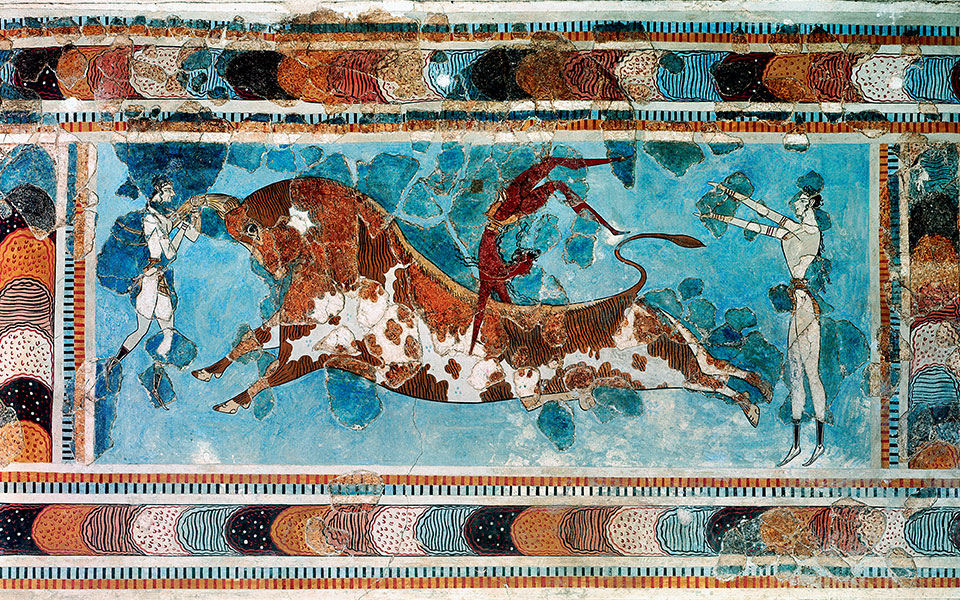After more than a century of archaeological scrutiny, key questions still remain about the Minoans of ancient Crete, reminding us just how far in the past the surprisingly sophisticated Greek Bronze Age (ca. 3300 BC – 1100 BC) lies – separated from our modern world by so many evidence-ravaging millennia that looking back now seems almost like peering into deep space at some distant planet.
The Minoans were great administrators, seafarers and traders, whom present-day investigators have successfully traced throughout Crete, across the Aegean, eastward to Egypt and westward to Italy. Yet, who were these early island people who could exert such influence over their regional neighbors, but who don’t appear to have had any military juggernaut – no bellicose navy or army – to penetrate, conquer and enforce, as their ships fanned out from Crete, expanding their commercial and possibly territorial interests?
Were they simply peace-loving, diplomatic merchants, whose Cretan products and native culture were so attractive and unthreatening that foreign societies welcomed their presence and sometimes – as at Akrotiri in Santorini – emulated their way of life? And if, indeed, the Minoans had no fighting forces, how could they have defended themselves against other seafaring peoples – who would surely have descended upon Crete after learning about its bountiful natural resources and its prosperous, highly developed civilization?
RESILIENT ROOTS
Although the prehistoric world of Greece still holds many mysteries, our view of Minoan Crete and its people has become increasingly sharp since the mid-19th century, thanks to amateur and professional investigators, both Greek and foreign, ranging from inquisitive sea captains and pioneering archaeologists, historians and linguists to today’s growing host of laboratory-based researchers.
Where once we focused on the Minoans’ artistic, architectural and technological achievements – attested by the rich assemblage of artifacts unearthed with the spade, and by historical texts and compelling mythological narratives – today we’re also capable of examining their DNA to track their earliest origins. In 2013, a genetic study of skeletal material from Minoan cave burials in Crete’s eastern Lasithi Plateau showed – through the recovery of ancient mitochondrial DNA – that the Minoans were descendants of the original Neolithic inhabitants of Crete who arrived some 9,000 years ago. These first settlers arrived from Anatolia as part of a wave of immigrants who also left a major genetic footprint in continental Europe.
Thus, the Bronze Age Minoans, founders of Europe’s first great civilization, had long shared close ties – even on a physical level – with both East and West. More remarkably, the American and Greek scientists involved in this 2013 study also discovered that the modern-day residents of the Lasithi area continue to exhibit prehistoric Minoan ancestry, through their inherited genetic profiles, after more than 3,000 years!
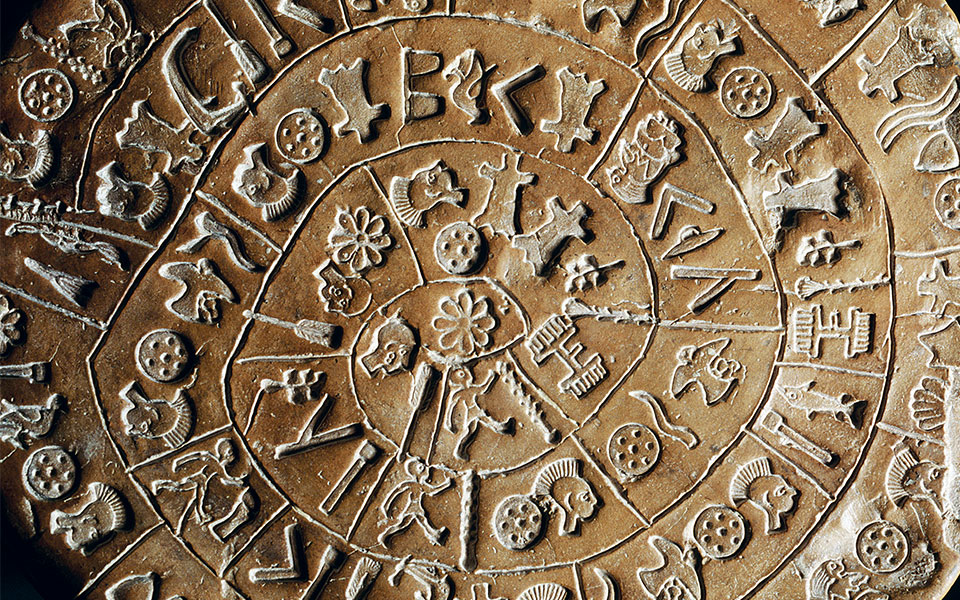
© Getty Images/Ideal Image, Mininstry of Culture and Sports/Irakleio Archaeological Museum
AGE-OLD MARINERS
As might be expected on an island, the sea played a ubiquitous role in Minoan life from its earliest days. Crete’s initial Neolithic settlers had had to cross the water, which in itself suggests that later prehistoric Cretans were long familiar with ships and navigation.
As the descendants of Crete’s earliest residents spread out from Knossos (already the island’s major population center in the Neolithic era), they developed ties with other Aegean islands. We know this from their tools made of obsidian, a material imported from Nisyros and/or Milos, and from subsequent imports or imitations of marble Cycladic figurines dating from the Early Minoan period (3300-2000 BC).
A more economically and politically advantaged ruling class emerged in this first stage of the Bronze Age, which in the second stage (Middle Minoan, 2000-1750 BC) went on to begin building characteristic palace complexes. Cretan ports at key locations, such as Poros Katsambas east of Irakleio, Mochlos and Palaikastro, steadily grew into busy emporia, dealing in local and imported raw materials and finished products.
AN ADMINISTRATIVE NETWORK
The first palaces were erected at Knossos, Phaistos and Malia. Smaller settlements, some with early monumental or palace-like buildings (e.g., Aghia Triada, Kommos and Zominthos), were also established around the island.
During Late Minoan times (1750-1490 BC) – after a devastating earthquake struck Crete ca. 1700 BC and the main palaces were consequently rebuilt – Minoan culture reached its brilliant zenith, with new secondary palaces founded at Kydonia, Archanes, Galatas, Gournia, Petras (Sitia) and Zakros. Together, these sites apparently served as a system of collection and redistribution centers for the agricultural crops, craft products, artistic works and other commercial goods that were the lifeblood of Minoan society and its domestic and overseas economy.
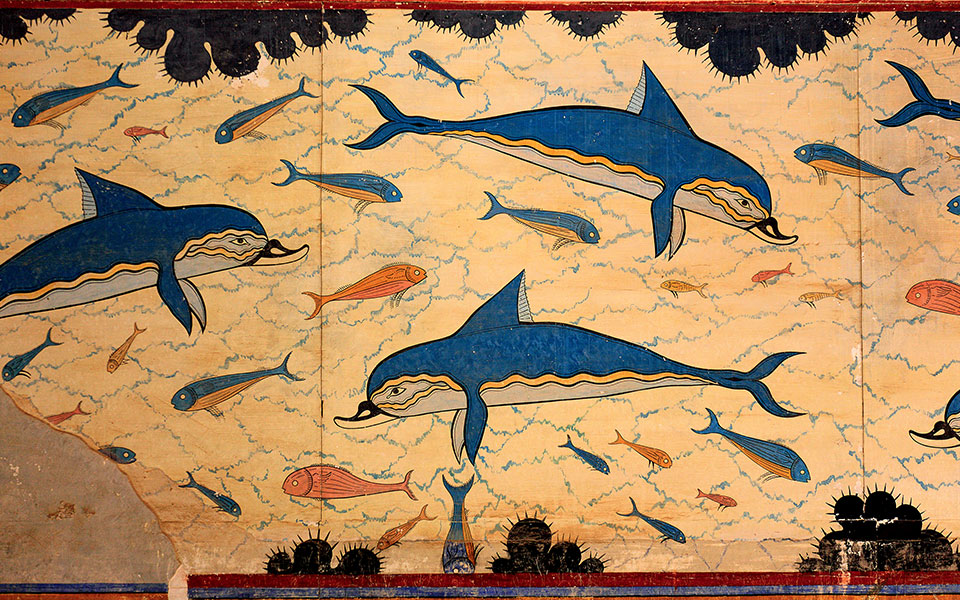
© Getty Images/Ideal Image, Mininstry of Culture and Sports/Ephorate of Antiquities of Irakleio
ARCHAEOLOGICAL EXPLORERS
Before Knossos became one of the birthplaces of the new discipline of archaeology – like Troy and Mycenae – in the late 19th century, curious local and foreign “sleuths” were already exploring Crete’s timeless landscape, enticed by legendary locales and characters mentioned by Homer and other Greek or Roman writers.
King Minos, Queen Pasiphae and the clever inventor Daedalus were just some of the well-known mythical figures that drew Captain Thomas Spratt, for example, in 1851-53, to tour the island and hunt for the exact location of the labyrinth where Ariadne had assisted Theseus to escape the monstrous Minotaur. “Crete’s own Heinrich Schliemann,” the Irakleio-native Minos Kalokairinos, a lawyer, businessman and antiquarian, was the first to confirm the location of the Palace of Minos at Knossos through a brief excavation in 1878, during which he revealed portions of the palace’s West Wing and West Magazines.
With Sir Arthur Evans’ arrival in the 1890s, and the start of his excavations and eventual reconstruction of the Knossos site in 1900, “Minoan” archaeology was born. Over the next three decades, Evans unveiled what was probably indeed the famous labyrinth – the palace itself – and a stunning succession of impressive artifacts. He also encouraged others to investigate ancient Crete – including the intrepid Harriet Boyd-Hawes, now recognized as a great female pioneer of Greek archaeology, who discovered and excavated Gournia in 1901-04.
The Minoan past was further illuminated by Greek scholars, including Spyridon Marinatos, Nikolaos Platon and J. A. Sakellarakis. One of Crete’s most inspiring and tragic archaeological figures was John Pendlebury, Evans’ successor at Knossos, serving as curator from 1930 to 1934. A tireless trekker, Pendlebury was reputed by locals to know the entire island intimately and to speak Cretan Greek like a native. He joined the British military in 1939, but was captured and summarily executed by the Nazis on the third day of the invasion in 1941. His grave can be viewed in the Allied War Cemetery at Souda Bay.
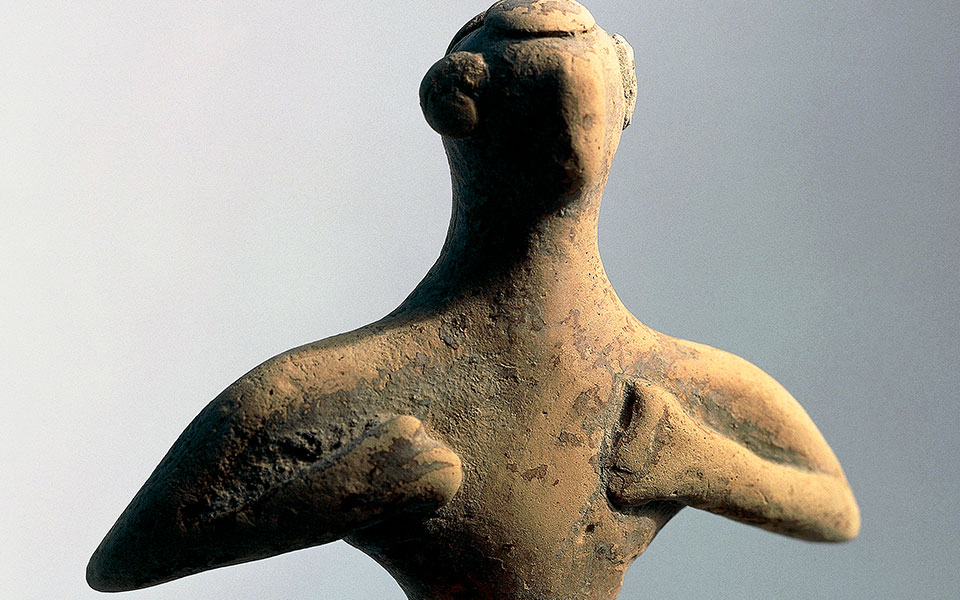
© Getty Images/Ideal Image, Mininstry of Culture and Sports/Irakleio Archaeological Museum
MINOAN PALACE “BLUEPRINT”
Knossos stands as the preeminent, archetypal Minoan palace, which in time grew to include over 1,500 rooms – a massive structure rising 3-4 stories and covering an area of about 20,000 square meters. The Phaistos and Malia palaces, in comparison, reached only about 10,000 and 7,500 sq. m. respectively. Meanwhile, the full “capital city” around Late Minoan Knossos occupied an area of some 750,000 square meters. From its initial foundation, Knossos essentially served as a model of distinctive architectural, functional and stylistic features that intriguingly also appear in the smaller palaces and in some country or “manor” houses all across the island.
Knossos’ extensive reconstruction by Evans, although initially criticized by Pendlebury and others, has led to significantly greater “comprehensibility” of the massive, multi-roomed and snakily-corridored palace. A stroll through the fascinating complex reveals its characteristic elements, including the central courtyard; main and subsidiary entrances; a west court; a series of storerooms; grand staircases; light wells; downwardly tapering columns; and a versatile “pier-and-door” construction which allowed rooms such as the Queen’s Megaron to be opened for air and light on warm, sunny days, or closed up snugly in inclement weather.
Additionally, one finds a northern hypostyle chamber (roofed, with interior columns); lustral basins (perhaps purification or bathing stations), cult halls, sacred-object repositories and craft workshops. Comfort and convenience were further ensured with piped or channeled water systems and drains. Knossos and Phaistos shared similarly stepped outdoor theatrical areas, while only the Knossos palace had a ceremonial “throne room,” in which, perhaps, the real-life Minoan monarch, an inspiration for the post-Bronze-Age mythical King Minos, once received his visitors.
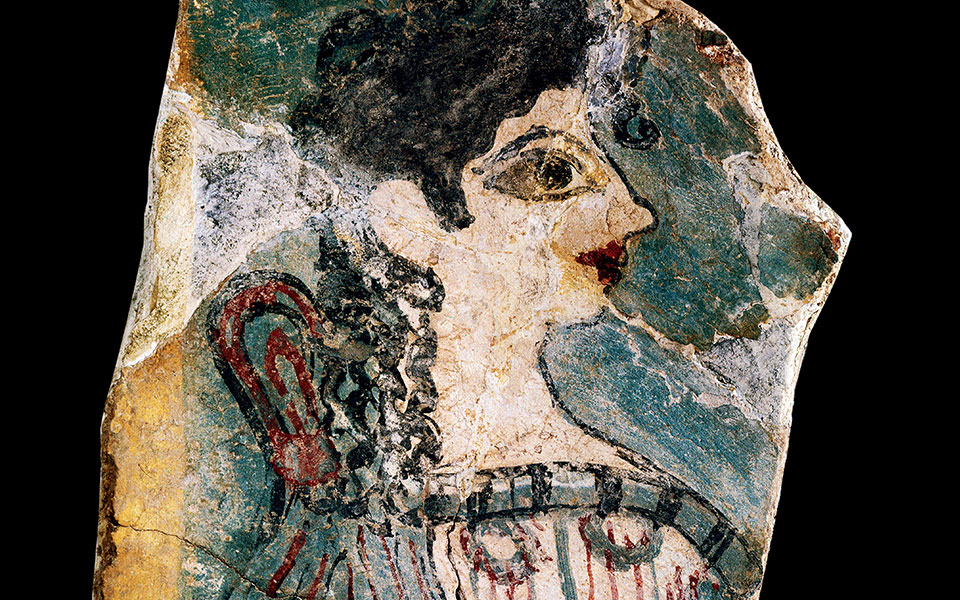
© Getty Images/Ideal Image, Mininstry of Culture and Sports/Irakleio Archaeological Museum
TELLTALE OBJECTS
The abundant artifacts recovered by archaeologists at Knossos and other important Cretan sites – impressively displayed in the newly refurbished Archaeological Museum of Irakleio – reveal the Minoans to have been an ingenious, peaceful, proto-literate people who cherished nature, art, vivid colors, religion and commerce. Among these telltale objects, the faience Snake Goddess figurine and variously rendered “Horns of Consecration” sculptures are iconic relics of Minoan culture. Boldly painted Kamares Ware and Marine Style pottery present floral and sea life motifs, while giant storage jars (pitharia) were both functional and ornately decorated with molded patterns.
Smaller treasures include engraved seal stones; clay circle-dancers; the golden-horned bull rhyton (a type of conical cup), the “Harvesters’ Vase” and other carved-stone drinking vessels; and finely crafted gold jewelry – such as the “Bee Pendant” from Chrysolakkos near Malia. Through these artworks, Minoan craftsmen referred to cherished aspects of their society’s spiritual beliefs, daily life, religious rituals and native Cretan environment.
Furthermore, ceramic models and painted plaques offer a glimpse of intact palace and house facades, while reconstructed wall frescoes depict finely plumed royals or courtiers; ladies with make-up and elegant coiffures and birds, bulls, dolphins and bull-leaping – the last seemingly a central ceremony in Minoan religion or in the elites’ entertainment. Elaborate burial rites and symbolic bulls, double-axes, horns of consecration, altars and sacred trees are detailed in the paintings of the Aghia Triada sarcophagus.
Early Written Records
Of particular importance are the many clay tablets bearing Linear A and B writing, which demonstrate the Minoans’ transition from a prehistoric culture based on oral communication and transmission to a literate, record-keeping society. Linear A texts, of the Early through Late Minoan periods and still untranslated, have been unearthed all over Crete (especially at Aghia Triada, Zakros and Kydonia/Chania); elsewhere in the Aegean; and in Laconia (southeast Peloponnese).
Similarly, Linear B script (Late Minoan, after ca. 1450 BC) – deciphered by Michael Ventris and John Chadwick in the 1950s – has also been recovered at both Cretan and mainland Greek sites, including Knossos, Malia, Pylos, Mycenae, Thebes and Tiryns.

© Getty Images/Ideal Image, Mininstry of Culture and Sports/Irakleio Archaeological Museum
THE TRUTH BEHIND THE MYTH?
As the Minoans used scripts mainly for preserving administrative information, they have not passed down written details of their religious or sociopolitical ideology. Later myths and legends of the Iron Age, however, seem to contain kernels of truth which reflect, to some degree, certain realities of Minoan life and foreign policy as they have been illuminated archaeologically over the past century.
The many bull objects and images discovered at Knossos, for example, and at other sites confirm the significant but still-mysterious role of bulls in the Minoan world, implied by the mythical story of the Minotaur. The unparalleled scale and grandeur of the architectural remains at Knossos, and the palace’s maze-like layout, give credence to the legendary royal figure of Minos and his labyrinth. Far-flung Minoan artifacts around the Aegean point to an imperial or commercial influence, perhaps alluded to in the Athenian hostages-tribute tale starring the heroic Theseus.
Likewise, archaeological evidence in Sicily, southern Italy and Sardinia indicate that the Minoans also traveled there – just as King Minos had, according to Herodotus, Apollodorus and others, while pursuing the fleeing Daedalus. On the Minoans’ real-life Western ties, Birgitta Palsson Halagger (1985) writes: “Crete offered luxury goods [ca. 1700-1430 BC] in exchange for needed raw materials, mainly European and Sardinian metals, and some finished products.”

© Shutterstock, Mininstry of Culture and Sports/Ephorate of Antiquities of Irakleio
DECLINE, DISSENSION AND DISAPPEARANCE…
In the end, Cretan power waned and the palace at Knossos was destroyed c.1370 BC. During this final “Postpalatial” period (1370-1100 BC), with Knossos in ruins, the island’s towns and villages became conversely more independent, as Crete’s now fully Mycenaean overlords ruled from the distant mainland. Many native Cretans moved inland to defensible, mountaintop settlements, such as Karphi, where they could protect themselves from an increasing inflow of Hellenic immigrants.
Despite this changing social and political climate, Homer records that Crete sent a contingent of ships to aid in the Trojan War (13th or 12th c. BC). As individual Iron Age city-states arose on Crete, the island’s communities became increasingly factious. Only centuries later did widespread peace and prosperity return under the Romans (1st c. BC), with Gortyn assuming the role of the island’s capital. Knossos, still an affluent community marked by Roman villas in the 2nd c. AD, continued to be a coastal center of maritime and military value during late antique and medieval times. Eventually, however, the site’s Kephala Hill was fully abandoned and the dusts of time came to obscure nearly all trace of the once-vibrant Minoans.
MAINLAND INVADERS
On two occasions, the great flowering of Minoan culture was abruptly interrupted by cataclysmic events. First came the volcanic eruption of nearby Thera (Santorini), now dated archaeometrically to ca. 1620 BC. To what degree the Minoans were impacted remains largely unclear, but some architectural changes are evident.
Better attested is a fiery, destructive event in the early 15th c. BC, which essentially wiped out every secondary Minoan palace and settlement. Somehow Knossos survived this calamity, which may have been a pan-Cretan invasion by foreign forces – specifically, the mainland Greek Mycenaeans.
Now began the Third Palace Period (1490-1370 BC), in which a new elite class or dynasty of “Creto-Mycenaeans” ruled the island without the aid of its subsidiary administrative centers. These previous palaces were all subjugated, while Crete’s Minoan/Mycenaean rulers (perhaps collectively the “Minos” of later myth) led the islanders to new heights, with an increasing mainland influence detectable in their art and religion. The more militaristic Mycenaeans – also renowned, far-sailing traders – seem to have spurred the Cretans to attain their greatest maritime/naval supremacy during this era.

